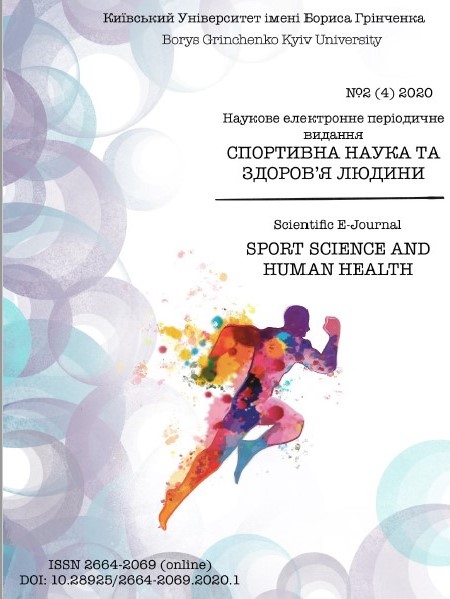MODERNIZATION OF SPORTS EQUIPMENT AS A FACTOR OF INCREASING OF DIFFICULTY SCORE OF COMPETITIVE ROUTINES IN TRAMPOLINE GYMNASTICS
DOI:
https://doi.org/10.28925/2664-2069.2020.2.5Ключові слова:
trampoline gymnastics, modernization of equipment, World Championships, World Cups.Анотація
Introduction.Trampoline gymnastics is a modern sport that has been included in the program of the Olympic Games since 2000.
Constant improvement of the sports equipment, changes and innovations to the international rules of competitions ensure the continuous development of the sport and the wide world popularity of trampoline gymnastics.
Aim is to acknowledge the relationship between the modernization of sports equipment and increasing of the difficulty score of competitive routines of athletes in trampoline gymnastics.
Material and methods: theoretical analysis of scientific and methodical literature, retrospective analysis of protocols of international competitions, video analysis, methods of mathematical statistics.
Results. The conducted research allowed to determine the main models of trampolines used at the international competitions in different historical periods; video analysis revealed the basic elements which formed athletes' competitive routines in 1964-1972; retrospective analysis of protocols of international competitions permitted to calculate the average, maximum and minimum difficulty scores of competitive routines of leading athletes in trampoline gymnastics at the World Championships and the World Cups from 1972 to 2020 and identify the interconnection between modernization of the trampolines and increasing of the difficulty scores of competitive routines of trampoline athletes in different historical periods of the sport development.
Conclusions. The led studies confirmed the interconnection between increasing of numbers of high difficult elements and difficulty scores of competitive routines of athletes and modernization of sports equipment in trampoline. According to the results of the research, the average difficulty score of competitive routines of qualified athletes raised from 0.2 to 0.5 points and maximum difficulty score from 0.1 to 0.7 points after introduction of each new model of trampoline.
Посилання
Danilov К. Complex trampoline jumps. Мoscow: Fizkultura i sport; 1969.
Rudkovskaya T, Kokhanskaya S. Pryizhki na battue: istoriya i sovremennost. Problеme Actuale Privind Perfectionarea Sistemului de Invatamint in Domenium Culturii Fizice 2014; 17(4): 237-242.
Khmelnitska I, Krupenya S, Lukjantseva G. Biomechanical analysis of kinematic structure of skilled female gymnasts’ technique in «Handspring» vault with a «vaulting table». Physicheskoe vospitanie studentov 2012; (5): 99-103.
Bare FL. The trampoline in American gymnastics. The U.S. Gymnast Magazine 1967; (12). https://issuu.com/usagymnastics/docs/1967_12dec (accessed 4 October 2016).
Blake T. Trampolining for All Ages (Know the Game), Revised ed. Stockholm: EP Publishing in collaboration with British Trampoline Federation; 1976.
Ćuk I, & Ferkolj S. Changes in technique of handspring double salto forward tucked performed on horse and vaulting table. Acta Kinesiologiae Universitatis Tartuensis. 2012; (4).
Eurotramp Product catalogue. https://issuu.com/parkandgarden/docs/catalogue_eurotramp-catalogue-50th- (accessed 22 July 2020).
Eurotramp Product information: Ultimate Trampoline. https://issuu.com/parkandgarden/docs/catalogue_eurotramp-catalogue-50th- (accessed 24 June 2020).
Eurotramp references. https://www.eurotramp.com/de-en/company/references/ (accessed 15 June 2020).
Fédération Internationale De Gymnastique. FIG apparatus norms. Lausanne; 2020. http://www.fig-gymnastics.com/publicdir/rules/files/en_Apparatus%20Norms.pdf (accessed 12 January 2020).
Furjan-Mandić G, Radaš J, Zaletel P, Gruic I. Factorial Analysis of Body Elements in Rhythmic Gymnastics. SciTePress. 2018; (6): 170-179.
Horne D. Trampolining: A Complete Handbook, 2nd ed. London: Faber & Faber; 1978.
Knoll K, Krug J. The vaulting table – a new vaulting apparatus in artistic gymnastics. XXVI International Conference on Biomechanics in Sports 2002; 112-116. http://www.coachesinfo.com/category/gymnastics/61/ (accessed 11 June 2020).
Limpert-Verlag W. Suggested Regulation for Trampoline Competitions per 1.1.63. Frankfurt; 1962.
Official website of the International Gymnastics Federation (FIG). https://www.gymnastics.sport/site/pages/disciplines/hist-tra.php (accessed 26 June 2020).
Trampoline code of points FIG, 2005-2008. Lausanne; 2004. https://www.yumpu.com/en/document/read/24898198/trampoline-gymnastics (accessed 15 June 2020).
Trampoline code of points FIG, 2009-2012. Lausanne; 2008. https://www.gymnastics.sport/site/rules/rules.php (accessed 15 June 2020).
Trampoline code of points FIG, 2013-2016. Lausanne; 2012. https://www.fgipuglia.it/wp-content/uploads/2017/03/Codice-dei-Punteggi-inglese.pdf (accessed 15 June 2020).
Trampoline code of points FIG, 2017-2020. Lausanne; 2016. http://www.fig-gymnastics.com/publicdir/rules/files/tra/TRA-CoP_2017-2020-e.pdf (accessed 15 June 2020).
Toledo E, Antualpa K. The appreciation of artistic aspects of the Code of Points in rhythmic gymnastics: an analysis of the last three decades. Revista Brasileira de Educação Física e Esporte 2016; 30: 119-131.
Tubney J. The Modern Gymnast. USA Gymnastics 1967; 4: 22-24. https://issuu.com/usagymnastics/docs/1967_4aprilmay (accessed 12 July 2012).
Yeadon M. Twisting Somersaults. Loughborough: SB & MC; 2015.
##submission.downloads##
Опубліковано
Як цитувати
Номер
Розділ
Ліцензія
Авторське право (c) 2021 Спортивна наука та здоров'я людини

Ця робота ліцензується відповідно до Creative Commons Attribution-NonCommercial-NoDerivatives 4.0 International License.











